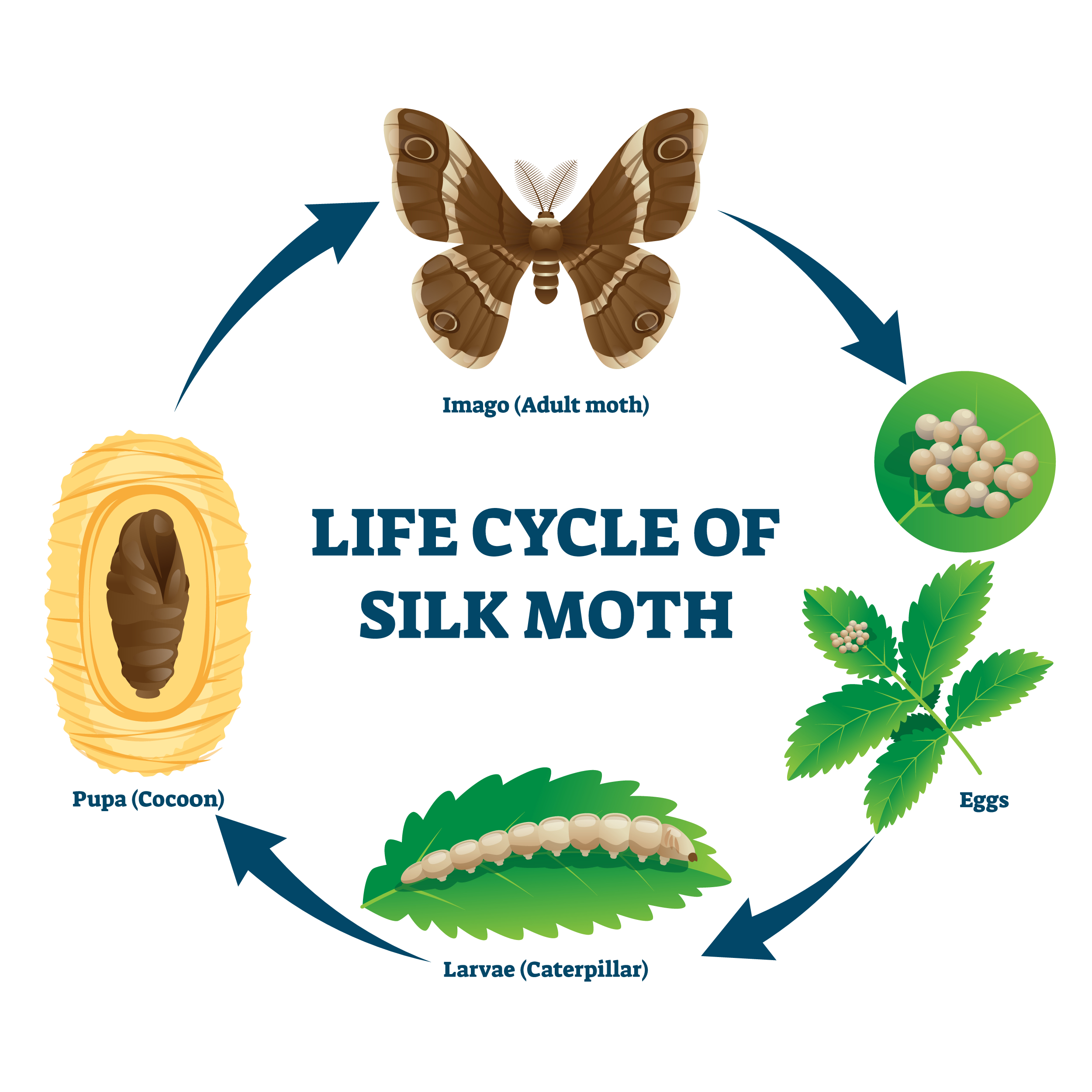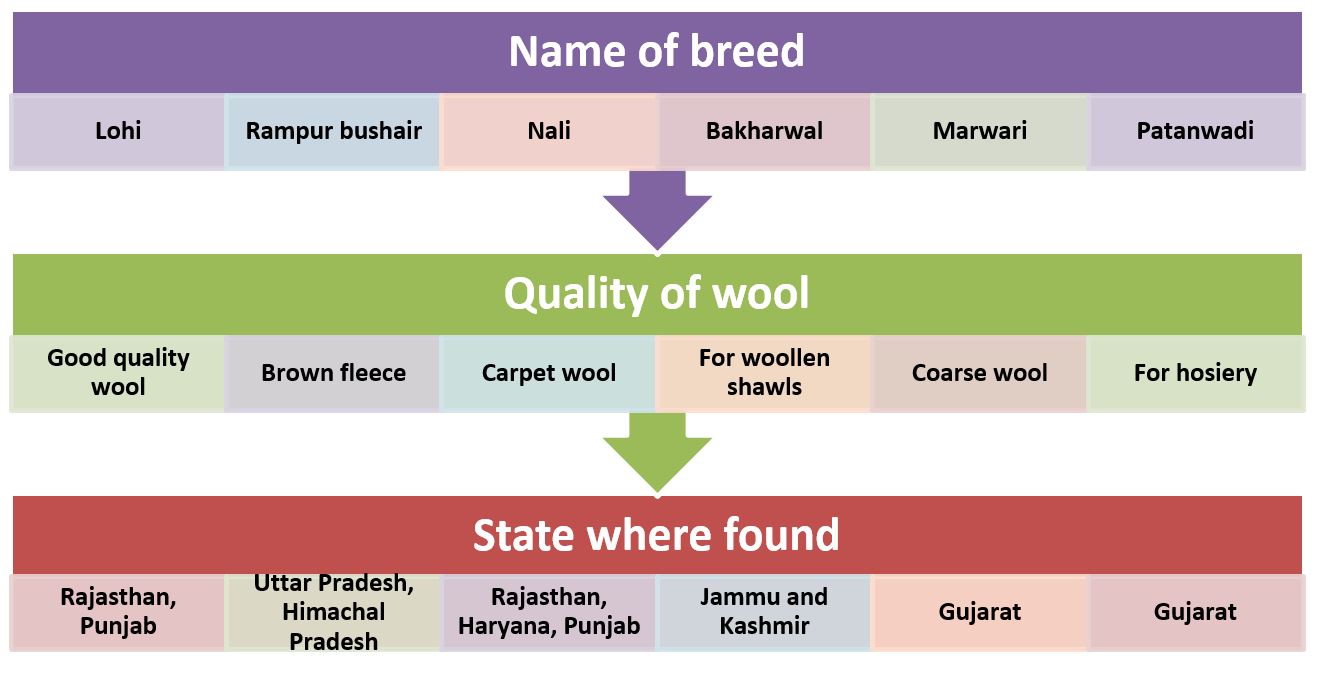Fibre to Fabric Class 7 Notes NCERT and MCQs
 24-08-2023
24-08-2023
 14:51 PM IST
14:51 PM IST
 Priyanka Chaudhary
Priyanka Chaudhary
The chapter discusses sources of two animal fibres. They are wool and silk. It also describes the processing of these fibres.
Wool
Wool is made from fibres obtained from fine soft under-hair of sheep. It is not obtained from the coarse beard hair of sheep.
Selective breeding: Selective breeding is used to give birth to sheep with soft under hairs from the breeds of sheep that possess only fine under-hair. Selective breeding is the process of selecting parents for obtaining special characteristics in their offspring, such as soft under hair in sheep.
Animals that yield wool
- Sheep yield wool that is commonly available in market.
- Yak wool is common in Tibet and Ladakh.
- Angora goats are commonly found in hilly regions such as Jammu and Kashmir. They give Mohair.
- The wool from Kashmiri goat is woven into fine shawls called Pashmina shawls.
- Fur (hair) on the body of camels is used as wool.
- Llama and Alpaca, found in South America, also yield wool.
Some Indian breeds of sheep: The table given below provides names of breeds of sheep, quality of wools obtained from them and names of the states where they are found.
Processing fibres into wool
The processing of fibres into wool comprises of six steps summarized below.
- Shearing: Shearing is the first step. In this step, the fleece of the sheep along with a thin layer of skin is removed from its body.
- Scouring: Scouring is the step in which the sheared skin with hair is thoroughly washed in tanks to remove grease, dust and dirt.
- Sorting: After scouring, sorting is done. The hairy skin is sent to a factory where hair of different textures are separated or sorted.
- Cleaning of burrs: In this step, the small fluffy fibres, called burrs, are picked out from the hair. Then, the fibres are scoured again and dried.
- Dyeing: The fibres can be dyed in various colours, as the natural fleece of sheep and goats is black, brown or white.
- Rolling: In this step, the fibres are straightened, combed and rolled into yarn.
Silk
Sericulture is the rearing of silkworms for obtaining silk. We get silk yarn from the cocoon of silk moth. Depending upon type of moth from which the cocoon is obtained, there are different varieties of silk such as tassar silk, mooga silk and kosa silk. The most common silk moth is the mulberry silk moth. It gives us soft, lustrous and elastic silk fibres.
Life history of silk moth: Caterpillars or silkworms are larvae that develop from eggs of female silk moth. The next stage of caterpillar is called a pupa. Caterpillar secretes fibre made of a protein which hardens on exposure to air and becomes silk fibre. Cocoon is the covering of caterpillar.

Fig: Life Cycle of a Silk moth
Rearing of silkworms and processing of silk
During rearing, the larvae, called caterpillars or silkworms, are kept in clean bamboo trays along with freshly chopped mulberry leaves. During processing, the cocoons are kept under the sun or boiled or exposed to steam. Reeling the silk is the process in which threads from the cocoon are taken out for use as silk.
MCQs based on NCERT Class 7 Science Chapter 3: Fibre to Fabric
1. Llama and Alpaca are the animals that yield wool. They are found in
a. North America
b. South America
c. South Asia
d. Europe
Ans. b
Explanation: Llama and Alpaca are found in South America.
2. Which of the following breeds of sheep is found in Gujarat?
a. Rampur bushair
b. Nali
c. Bakharwal
d. Patanwadi
Ans. d
Explanation: Marwadi and Patanwadi are the breeds of sheep found in Gujarat.
3. During rearing, the silkworms are kept in clean trays made up of
a. Bamboo
b. Paper
c. Mulberry
d. Mango wood
Ans. a
Explanation:
During rearing, the larvae, called caterpillars or silkworms, are kept in clean bamboo trays along with freshly chopped mulberry leaves.
4. The silkworm is (1) a caterpillar (2) a larva. Choose the correct option.
a. (1) only
b. (2) only
c. Both (1) and (2)
d. Neither (1) nor (2)
Ans. c
Explanation: Silkworm is both a caterpillar and a larva.
5. Which of the following does not yield wool?
a. Yak
b. Goat
c. Camel
d. Woolly dog
Ans. d
Explanation: Yak, Camel and Goat are wool yielding animals.
6. Which of the following is not one of the steps involved in the processing of wool?
a. Scouring
b. Shearing
c. Burning
d. Dying of fibres
Ans. c
Explanation: The steps involved in the processing of wool are: Shearing, Scouring, Sorting, Picking of burrs, Dying of fibres and Making of yarn.
7. Which of the following pairs is not matched correctly?
a. Scouring- Cleaning sheared skin
b. Mulberry leaves- food of silkworm
c. Yak- Reeling
d. Cocoon- Yields silk fibres
Ans. c
Explanation: The correct match is given below:
1. Scouring- Cleaning sheared skin
2. Mulberry leaves- food of silkworms
3. Yak- wool-yielding animal
4. Cocoon- Yields silk fibres
Frequently Asked Questions (FAQs) about Fibre to Fabric
What is Sericulture?
What is shearing?
What are the two fibres obtained from plants?
Share Blog


 Latest
Latest 
Comments